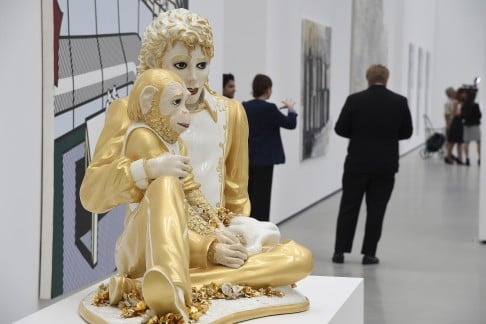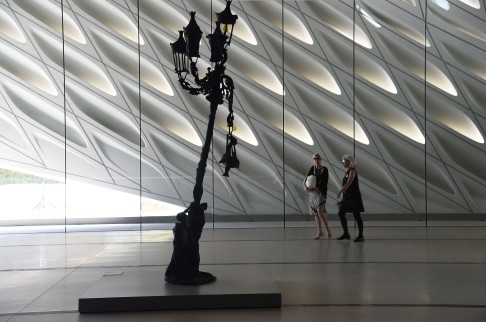
Los Angeles paean to pop art, The Broad, is a patchy parade
Opening show at one of the world's newest art museums - a showcase for Eli and Edye Broad's decades of collecting - is not the sweeping, chronological journey it promises, but the depth of representation of individual artists makes the visitor linger
American billionaire philanthropists and art collectors Eli and Edye Broad this week launched their US$140 million museum, The Broad, with a 50,000-square-foot exhibition drawn exclusively from its wide-ranging permanent collection.
Roughly 250 pieces by about 60 artists have been chosen from about 2,000 possibilities by nearly 200 artists.
But any curator will tell you that it takes time to learn a new building’s personality quirks – to figure out how best to configure temporary walls, take advantage of sight lines that let art pull a visitor through the galleries and calibrate an installation so that objects visually speak to one another. The Broad’s inaugural installation began only in June. That’s quick.

The museum bills the exhibition as “a sweeping, chronological journey” through the collection. But, in addition to feeling random (why this artist and not that one?), much of the best work has been seen before. Two large Broad exhibitions – in 2001 and 2008 – were held at the Los Angeles County Museum of Art.
The strongest feature is the collection’s depth in the representation of individual artists, especially pop-art-related. When the couple commit to acquiring an artist’s work, usually they collect in depth.
Few museums have the resources to acquire, say, two dozen Jeff Koons sculptures, as The Broad has. (The inaugural features eight – plus one dreadful painting, a medium for which he has no talent.) Several bountiful single-artist rooms make you linger longer.

Among Andy Warhol’s 11 paintings is a 1962 Dance Diagram correctly displayed on the floor, not hanging on a wall. Roy Lichtenstein’s 10 pop paintings provide a stunning survey of his 1960s breakthrough, giving mass-media makeovers to Impressionist, Fauve, cubist and other historic paintings.
Just four Ellsworth Kelly paintings fill another room, but their seamless fusion of bold geometric shapes, crisp composition and saturated colours grabs you by the lapels. Among them is one from a breakout 1963 series, a masterpiece acquired two years ago.
A vivid green rectangle and a bright blue oval are surrounded by a crimson field. All calmly share the same flat plane, perfectly balanced in scale and chromatic intensity, yet straining to burst their optical bonds. Kelly makes poise look easy.

Closer to the present, five paintings and sculptures by Takashi Murakami push the collection’s pop-art focus forward in time. Murakami’s creepy cartoon cheerfulness about a Japanese society riven by post-atomic tensions takes a monumental turn in a new, 25-metre-long mural.
In the Land of the Dead, Stepping on the Tail of a Rainbow conjures a mythic narrative inspired by the 2011 earthquake and tsunami that tore open the Fukushima Daiichi nuclear power plant. Great waves of storm-tossed sea monsters cavort around a grim mountain of skulls – a landscape of elegant, stylishly sophisticated awfulness.
Perhaps the most viscerally gorgeous room is Cy Twombly’s, with seven lush paintings and three ghostly sculptures. A difficult artist, especially for audiences of the “my child could do that” school of fusty art criticism, Twombly’s paintings mix drawing and writing. The aim is to free them from established strictures of earth-bound depiction.

I wish the exhibition continued on this way, with only monographic rooms. A core collecting philosophy for nearly 40 years would take centre stage.
Instead, except for rooms for John Currin and Glenn Ligon, the show mostly flips into conventional mode. Packaged art movements popular in New York in the late 1970s and after are chronicled. Blandness settles in.
Another issue the museum shows – and indeed The Broad’s collection – is how much the couple’s art is influenced by the market.

Subject to commercial limitations, the market is hardly infallible. It leaves a lot out. That’s why the show’s “sweep” feels choppy, and why about 80 per cent of the 92 artists featured in the collection’s new catalogues are male, which the art market favours.
It’s also why the show stresses art from New York and Europe, where art’s primary trading floors are located, but not Los Angeles, where the collection was assembled.

Ironically, in Tips for Artists Who Want to Sell, his cheeky 1966-68 sign painting, Los Angeles’ John Baldessari gives the sardonic lowdown. “Paintings with cows and hens collect dust,” it declares, “while bulls and roosters sell.”
Markets always distinguish between what’s saleable and what’s not, but they can’t calculate quality.
Los Angeles Times
